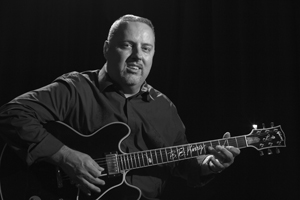In The Name of Love
Eric Dahl traces B.B. King’s everlasting affair with Lucille
Booksellers’ shelves are thick with biographies of popular musicians, but detailed explorations of the relationships between players and their favorite instruments are far less common. That’s not for lack of real-life drama: just ask B.B. King, one of the most revered blues performers of all time, who is seldom seen without a shining black Gibson guitar named Lucille. In 1949, a brawl over a woman named Lucille resulted in a fire at a house where King was performing, and the entertainer narrowly escaped with his life and his livelihood—his only guitar—intact. As a reminder, King named the instrument, and each subsequent guitar he’s played onstage, after the lady in question. In his new book, B.B. King’s Lucille and the Loves Before Her, Nashville writer Eric Dahl chronicles the most significant instruments in King’s development as a musician, from the one-string diddley-bow King played as a boy to the eighteenth iteration of Lucille that shares the stage with him today.
The lovingly-researched volume contains a wealth of technical information, from the height of Lucille’s strings above her fretboard to the model of the custom speaker installed in King’s amplifier. Dahl writes so that fans with even a cursory knowledge of guitars can understand how each detail of construction affects Lucille’s sound. These features include the lack of f-shaped holes found on the top of similar models but absent from the Lucille that Gibson manufactures to King’s specifications. They are left out for a very practical reason: over decades of playing semi-hollow-body guitars on loud stages, King grew tired of stuffing the holes with whatever absorbent material was at hand to prevent squeals of electronic feedback.
 Dahl brings Lucille’s story to life with help from a variety of people who know her well, including Gibson staffers who designed and built her and members of King’s entourage who keep her ready to play. Dennis Chandler was an extraordinary fan of King’s work, so inspired that he took a job at Gibson, where he orchestrated the production of the first signature-model Lucille in 1980. Charlie Dennis, King’s rhythm guitarist since 2006, is responsible for Lucille’s care and upkeep on the road—no easy feat, considering that King, at age eighty-seven, takes his band out for at least 100 dates every year (and only recently scaled back from 250). Dahl himself becomes part of Lucille’s story when his pawn-shop find turns out to be a beloved prototype, stolen from King’s home and thought lost forever.
Dahl brings Lucille’s story to life with help from a variety of people who know her well, including Gibson staffers who designed and built her and members of King’s entourage who keep her ready to play. Dennis Chandler was an extraordinary fan of King’s work, so inspired that he took a job at Gibson, where he orchestrated the production of the first signature-model Lucille in 1980. Charlie Dennis, King’s rhythm guitarist since 2006, is responsible for Lucille’s care and upkeep on the road—no easy feat, considering that King, at age eighty-seven, takes his band out for at least 100 dates every year (and only recently scaled back from 250). Dahl himself becomes part of Lucille’s story when his pawn-shop find turns out to be a beloved prototype, stolen from King’s home and thought lost forever.
Aside from stories King shared when Dahl returned the stolen Lucille and quotations offered second-hand from members of his organization, King says little in the book about the guitars that have been his constant companions. An artist for whom feel always trumps technical details, King may be inclined to let Lucille do the talking, but this book would have benefitted from greater access to King: his voice would have added weight to key anecdotes that remain unresolved or uncorroborated. Nevertheless, B.B. King’s Lucille and the Loves Before Her is a valuable resource for anyone who’s been held spellbound by King and Lucille.
A skilled guitarist can make expressive music with almost any instrument, but the right guitar can draw a performance out of a player that he may not have known was there. B.B. King depends on Lucille to help him deliver that magic night after night, and B.B. King’s Lucille and the Loves Before Her offers a unique inside look at where it comes from.
Eric Dahl will discuss B.B. King’s Lucille and the Loves Before Her at Parnasus Books in Nashville on January 16, 2013, at 6:30 p.m.


